We’ve now spent even more time on the Sick Day 114, both in the resort with alpine bindings, and in the backcountry with touring bindings. Jonathan Ellsworth has spent time on the 190 cm version of the ski (as have Cy Whitling and Paul Forward), and Luke Koppa has been skiing the 180 cm version. So let’s get to it.
Firm, Smooth Snow
Luke Koppa (5’8”, 155 lbs): On very firm, smooth snow, I’ve found the Sick Day 114 to perform about as I’d expect of a 114mm-underfoot ski with a decent amount of tip and tail rocker. It doesn’t feel particularly quick edge-to-edge, and when things moved to the icier end of the spectrum, I definitely felt limited to skidded / drifted turns. But if the snow was pretty consistent (e.g. smooth chalk), or the groomers were fresh, I was able to carve medium- to large-radius turns at moderate edge angles on the Sick Day 114.
And when things softened up at all…
Soft Groomers
Luke: I had a lot of fun on the 180 cm Sick Day 114 in any sort of soft conditions. On soft groomers (even when they were a bit roughed-up), I was able to carve confidently and more aggressively than I could on firmer snow.
When opening things up and letting the skis run, the 180 cm Sick Day 114 does have a speed limit, but I was surprised by how hard I could push this ski, especially given its ~1930 g weight. And when I did feel that the ski was getting a bit jittery, I could very easily and predictably shut things down. In terms of overall stability, I thought the 180 cm Sick Day 114 felt pretty strong for its weight, even compared to longer skis of similar weights.
Jonathan Ellsworth (5’10”, ~175 lbs): I’ve only skied the 190 cm SD 114, and I haven’t really skied it yet on very firm snow. But on soft groomers, the ski performs just fine. I wouldn’t be tempted to put it in the competition for the best 115mm-wide carver I’ve ever been on (where the old Line Influence 115 would still be on the podium), but I can’t think of anything about the Sick Day 114’s carving performance that was odd, unpredictable, or disappointing. Fact is, I really enjoyed the time I spent on both the 186 cm Line Sick Day 104 and the 190 cm Sick Day 114.
Slush
Luke: In slush, the 180 cm Sick Day 114 is a blast. Its wide platform and fairly deep tip and tail rocker lines keep it from feeling hooky, and its above-average stability (for a ski of its size and weight) makes it a ton of fun to mob down slushy, off-piste snow. For spring skiing at a place like A-Basin where the snow is soft, forgiving, full of patches to jump off of, and there’s plenty of wide-open terrain, the Sick Day 114 feels like an excellent ski. It doesn’t get caught up in soft, inconsistent snow, it’s stable enough to hold up to pretty high speeds in forgiving snow, and it’s light and poppy enough to encourage me to try and jump off everything I can find.
Jonathan: The 190s are a total blast in slush. I could literally copy and paste what Luke just wrote about the 180 Sick Day 114s, but with the 190s, you are working with a bump up in weight and stability, and I felt like I could push the 190s almost as hard as anything else out there. (Of course, the more you introduce weird moguls or firmer, variable snow into the equation, that’s where heavier, stiffer skis start to regain their stability advantage.)
Anyway, these are just an extremely fun ski in slush and isothermal snow.
Powder
Luke: As the widest ski in the Sick Day series, I expected the Sick Day 114 to do well in deep snow, and overall, it did.
I’ve skied the Sick Day 114 in up to around 2 feet of snow, and in those conditions and anything shallower, I was pretty happy with the float of the ski. On really deep days I think I would prefer the 190 cm version as the 180 cm Sick Day 114 felt just a bit short when trying to drive its shovels or when jumping into deep snow. But given how much I enjoyed the 180 cm version in non-powder conditions (especially soft spring days), I had no problem with the float of the 180 cm Sick Day 114. Its softer tips plane well, and I never experienced any major tip dive.
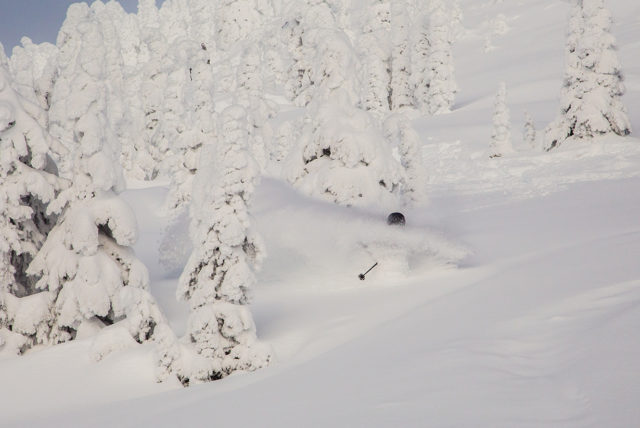
Though I could definitely break the tails free on the Sick Day 114 in deep snow, I wouldn’t call it a particularly surfy ski. I skied the Sick Day 114 at mount points ranging from the -10.4 cm recommended line to 3 cm forward of it, and it was noticeably easier to slash / slarve when mounted forward (+3 cm was my favorite mount position). In tight trees, the 180 cm Sick Day 114 felt pretty easy to turn, and offered a nice combo of maneuverability and float.
Jonathan: While Luke got the 180 cm Sick Day 114 in deeper snow than we have (so far) had the 190 cm Sick Day 114 in, nothing about Luke’s description really surprises me. I stuck with the 190 cm Sick Day 114 mounted on the line, so it is very much set up as a directional ski, one that’s better suited to fall-line skiing than bee-bopping or tricking your way down the mountain (at least when mounted on the line). And that type of ski — for a ski of this width — works quite well for me. Because if I’m on a ~115mm-wide ski, I’m less concerned about pure-deep-powder performance, and more about how well the ski performs in chopped-up snow. Point is, Luke is right; there are surfier — and much wider — pow skis out there (e.g., 191 DPS Alchemist Lotus 124), but if you tend to ski pow with a bit of speed, the 190 cm Sick Day 114 is still just heavy enough and just poppy enough to be fun in untracked snow, while still performing like a solid all-mountain ski in less pristine conditions.
Soft Chop
Luke: I spent a couple days on the Sick Day 114 at Revelstoke, during and after a sizable storm, so I ended up skiing a lot of chopped-up snow. In soft, early-day chop, I was impressed by how well this (fairly light) ski held up to skiing hard and fast. It didn’t completely blow through the soft piles of snow like a heavier ski, but as long as I skied with a more active style, I had a lot of fun on the Sick Day 114 in soft chop.
Jonathan: As for the 190 cm Sick Day 114, let’s just get this out of the way: if you primarily want a chop destroyer, I would still go with the 190 cm Moment Blister Pro. But not everyone wants to go that wide, and the 190 cm Blister Pro is a bit more work than the 190 Sick Day 114. The good news for skiers is that there are a lot of good options in this width range, so it’s really just about figuring out what you’re really looking for. In my initial review I said that, “I would not call the 190 cm Sick Day 114 a soft / variable charger, but I would say that you can ski it quite hard in soft / variable snow.” But having spent more time on the ski, I’m inclined to qualify this a bit. The 190 cm Sick Day 114 is not some heavy missile, and there are burlier ~115mm-wide skis on the market. But when skiing with a bit more dynamic style, I quickly got quite comfortable with the stability of this ski in softer chop, and the ski never felt demanding or unforgiving to me at all. So I think this is a ski that can be pushed pretty hard / quite hard, but it will let you take your foot off the gas when you want to, and it won’t kick your ass or penalize mistakes.
Firm Chop / Crud
Luke: Once the chopped up snow had gotten pretty firm, I felt that I had to tone things back a bit on the 180 cm Sick Day 114. Here, it became even more important to stay light on my feet as I navigated the firm piles of snow. The ski still remained predictable / manageable, but this sort of snow was where I most noticed the Sick Day 114’s lower weight. But like the Sick Day 104, I think the Sick Day 114 has a very good stability-to-weight ratio. It’s by no means some chattery touring ski that you only want to take out in pristine snow.
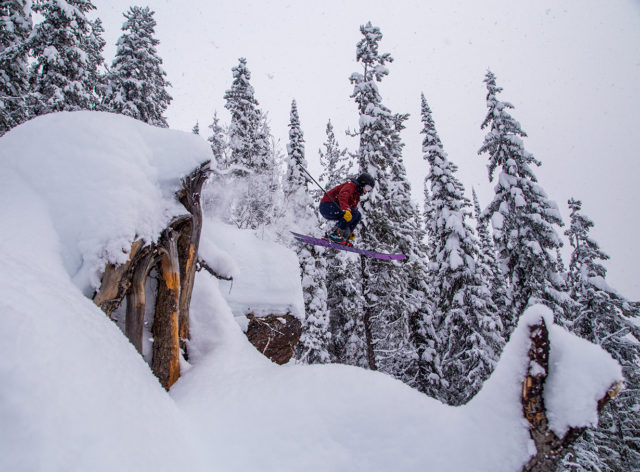
Jonathan: Again, I’ve only skied the 190 cm Sick Day 114, so I’ll assume that it’s heavier weight gives it the edge over the 180 cm model. And I’d still take the (extra weight of the) nearly 2400 g 190 Blister Pro over the ~2120 g 190 Sick Day 114. But I’d also rather ski the Sick Day 114 in firm chop and crud than any number of other skis on the market of this width. And I think skiers who are lighter than me (I’m ~175 lbs) or ski with more finesse will find the 190 Sick Day 114 to be quite stable.
Mount Point
Luke: I tend to prefer skis with more progressive mount points, so the Sick Day 114’s -10.4 cm mount point worried me at first. And while the ski definitely feels directional and rewards a forward stance, I didn’t find it punishing when I got in the backseat. I ended up settling on a mount point of +3 cm, and there I felt that I could ski the Sick Day 114 with a slightly more centered stance and the tails felt easier to break loose.
Jonathan: I see a number of LINE athletes on the Sick Day 114, and I highly doubt that any of them are mounted back on the recommended line. I’ve stuck with the line — and see zero reason to mount behind it, but directional skiers who are used to traditional mount points will still find the Sick Day 114 to be pretty poppy and easy to get up in the air.
[shot of JE jumping on rocks]
Durability
Luke: I haven’t been very nice to the Sick Day 114. I used it during several masochistic summer / fall backcountry ski trips, and those days often involved a lot of rocks and terrible snow. Then, while at Revelstoke, I misjudged how flat one of the pillows was and jumped on it only to be stopped dead in my tracks, with the skis punching through the snow to the rock below.
Afterward, I saw the extent of the damage: a small coreshot, a bent edge, and the ski had delaminated near the point of impact. While I have no idea whether another ski would have left that impact intact, it did make me think about the potential correlation between lighter skis and long-term durability. Then again, we don’t know any ski manufacturers that would encourage you to jump off a pillow onto a rock on their skis.
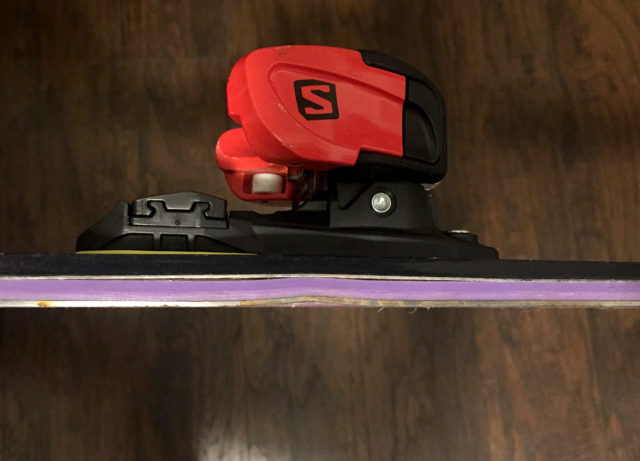
Jonathan: Cy Whitling, Paul Forward, and I clearly aren’t as dumb as Luke, so we haven’t jumped directly on to rock. Okay, actually that’s not true — literally in that shot of me above … I landed on rock. I just checked our pair of 190s again, and there is no edge damage, no coreshot; just a scrape in the p-tex (that was so minimal that I skied the SD 114 this past spring without even tuning the ski again after that rock hit). The takeaway? Same as always, really: try not to land on rocks. But if you regularly do, it’s generally a good idea to go with heavier skis as opposed to lighter skis.
50/50 — Backcountry and Resort
Luke: I think the 180 cm version of the Sick Day 114 makes a lot of sense as a 50/50 ski. Though some people might find it a bit heavy for a dedicated touring ski, and others might prefer a heavier ski for firmer conditions in the resort, I think the Sick Day 114 strikes a really nice balance. Whether I was touring on it or skiing inbounds, I never felt that I was on an inappropriate ski.
And that’s something that I also found to be true for the Sick Day 104 — these Sick Day skis just feel really dialed in terms of offering good enough stability for skiing pretty hard in the resort, while coming in at weights that are light enough for the skintrack.
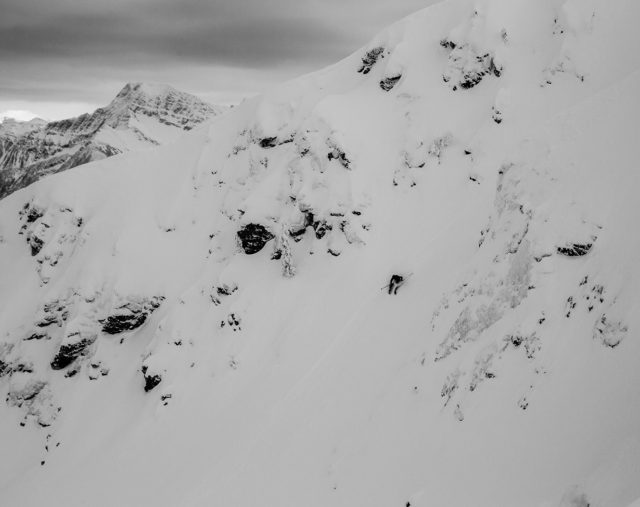
Jonathan: I really view the 190 as more of a resort ski, and of all the skis on the market, I wouldn’t be mad if this was my wider ski for resort powder days in the Rocky Mountains. That said, if you slapped a good AT binding on the 190, you’d have a very capable touring ski that will be very solid on the way down … so it really just depends on how much ski you’re willing to drag uphill.
Length — 180 cm vs. 190 cm
Luke: Though I’ve spent the majority of my time on the 180 cm version of the Sick Day 114, I have spent a bit of time on the 190 cm version (bindings mounted at recommended). At 5’8” ~155 lbs, I did think the 190 cm Sick Day 114 felt like a fairly big ski. I appreciated that extra length on groomers and areas where I could let the skis run, and I thought it offered a noticeably more stability at speed compared to the 180 cm version. However, I definitely preferred the 180 cm version in moguls, tighter terrain, and for touring. While I’d still happily ski the 190 in the resort, the only time I was really wishing for more ski than the 180 cm version was in really deep snow, since I was pretty happy with the stability of the 180, even in open spaces. And since I’m not often skiing 2+ feet of powder, I’d stick with the 180 cm Sick Day 114 if I had to choose one.
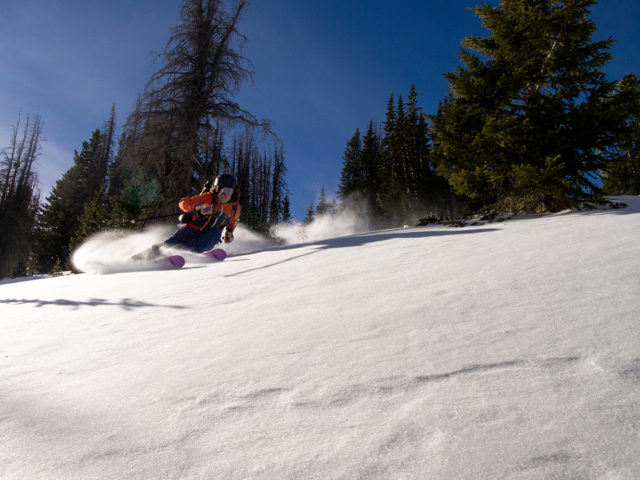
Jonathan: While I haven’t skied the 180s, I’d stick with the 190s, mostly because, for me, I liked their blend of stability, quickness, and poppiness. (But to be clear, I tend to like heavier, stiffer, very stable skis, so those who generally like the opposite — lighter, softer, and more quick than stable — ought to keep this context in mind. The 190 cm Sick Day 114 certainly isn’t the most stable or quickest or poppiest ski out there … but that’s the whole point — very quick skis and / or really poppy skis rarely provide the amount of stability I tend to like. So this is one of those times when failing to come in #1 in any given area actually makes this ski more interesting to me than most of the other skis of this width that might take best-in-class in just one of these categories.
Bottom Line
The Line Sick Day 114 is a pretty versatile powder ski that is a lot of fun in soft conditions, whether in or out of the resort. While it doesn’t excel in really firm snow or have the crud-busting ability of heavier skis, it performs well for its weight. For intermediate to advanced skiers looking for a 50/50 ski for soft and / or deep days — or those who prefer lighter skis inbounds (that don’t suck in cut-up snow the way light skis tend to suck in cut-up snow), the Sick Day 114 is certainly worth a look.
Deep Dive Comparisons: Line Sick Day 114
Become a Blister Member or Deep Dive subscriber and check out our updated Deep Dive of the Sick Day 114 to see how it stacks up against the Moment Bibby / Blister Pro, Rossignol Super 7 RD & Super 7 HD, DPS Alchemist Wailer 112, ON3P Wrenegade 114, Faction Dictator 4.0 Fischer Ranger 115 FR, Nordica Enforcer Pro, ON3P Kartel 116, Line Mordecai, Blizzard Rustler 11, and more…
NEXT: ROCKER PROFILE PICS

What do you think: Rustler 11 or Sickday 114?
Those 2 skis are going to ride completely differently IMHO, rustler 11 has metal in it and is stiffer/heavier. Sick day is lighter and has more early rise rocker. I ride them both at my home resort, I also ride the nordica enforcer 110 which is similar to the rustler 11. Try them all out, I love them all. Cheers.
Hi Mike, can give a (short) overview of the differences between those ski’s. That will help me a lot, all three of them are on my shortlist :-).
I am looking for a successor for my rossignol soul 7 (one of the first generations). My soul 7’s are/were fine, but they miss some float and are a bit too short (180) for me (182cm / 8’11,5″). I also prefer a more stable ski at speed and not the floppy tip of the soul 7, but still requires some playfulness.
The binding will be my kingpin’s, I want to have the best possible do it all ski for my preferences. Not a burly charger. Good edge hold en some carving abilities will be some added values.
How does it compare to the Armada Norwalk?
How does the Sick Day compare to the Supernatural 115/newer Influence 115?
I would also like to know…
The supernatural has more camber and also has a piece of metal running through it giving it more weight and stiffness than the sick day. Both are great skis, go demo them.
As someone with a 2014 sick day 110, I’m looking for a ski that is at least as stable, with a bit fore floatation, and is easier to break free/slash in powder. Would this fit the bill?
Hi there!
I used to ski a Wailer 112 Hybrid in a 184- Liked it. Need something wide/floaty again. Will the SD114 (180) fit the bill? The Wailer was relatively undemanding, medium flex and floated great. How will the SD compare in terms of flex and general ease of skiing? As a sidenote, current Wailer 100 Foundation, had to sell again because it was WAY to stiff. Thanks!
Are you sure about the -10 mounting point? Line do list something like -8?
Yes, our measured mount point is correct for how we measure mount points for all the skis we review. For the mount points we list, we simply measure the distance from the true center of the ski (true center being our measured length of the ski, divided by 2).
The way that Line lists their mount points is a bit different. This is how their engineer summed up how they come up with their listed mount points: “our center mark is not the center of the ski but the center of the designed running surface length (you could think of it as a core center of sorts).” So when they list the distance from the mount point to “center,” their center point is not always the “true center” point that we measure.
Since some brands list mount points in different ways, we measure all of ours exactly the same, in an effort to keep them consistent and comparable across different brands. But for all of our ski reviews, the measured mount point is simply how far back the recommended line is from the true center of the ski.
Hi, excellent answer! Thanks!
It just caught my eye that maybe the review tile is wrong, it says 19/20 but shows the 18/19 ski (and the older 17/18) and was written in 2018?
Anyway, a Line Rep just answered a mail of mine saying that Line changed the mounting point from 17/18 to 18/19, can you confirm or comment?
Cheers!
Ps just ordered a 17/18 SD114
Hi, looking for a wider set of skis to use when touring, i have looked at the sick days 114 and the rustler 11, in 190 or 192 cm. i have a pair of sick day 104 that i love and are super fun. Looking for a ski to use in high speed, but at the same time, a ski that turns quickly and is playfull. Which would you choose?
Sounds like you’re describing a fun inbounds setup with alpine bindings, not a touring setup with tech bindings. You find yourself skiing high speed, turning quickly, and hitting features on an every day/normal tour? What bindings do you intend to use? Kingpins? Shift mnc?
I’m currently looking at picking up a pair of 2020 Sick Day 114’s in the 190 length on a pretty sweet deal, the price is right. Before I pull the trigger, I figured I’d see if anyone had input for me.
About me: I’m def on the bigger end of skiers at 6’2″ and approx 250lbs with gear on. I ski all over the Wasatch and I’m looking for a new dedicated pow/soft conditions ski for inbounds. Other skis in my quiver: 4FRNT MSP 99 that I ski as a daily driver in anything from firm conditions up to 8″ of fresh. I also have a dedicated touring set-up, so I wouldn’t be using the Sick Day 114 for more than bootpacking around a resort.
I’m looking for the Sick Day 114’s to replace two skis for me:
1. 2014 Line Sick Day 125’s | 192 length = these need to get retired or made into a dedicated rock ski, but I LOVE them. They’ve been my favorite pure pow ski ever due to their playfulness, float, and ability to pivot on demand in tight situations. I also found them impressively versatile as long as conditions stay soft.
2. 2015 Line Supernatural 115’s = Perhaps the best big mtn ski I’ve ever owned. They got it done in powder when the terrain was steep and open, but imo take more effort to break free or pivot when things get tight. While definitely less playful than the Sick Day 125, where they REALLY shined for me was mobbing crud. Also found they held an edge well on a groomer for their size.
So I guess my question is: If I’m looking for a best-of-both-worlds ski that combines the ability of the two skis above… would that be the 2020 Line Sick Day 114?